GREETINGS

NIMH Director Thomas Insel, MD
There has been much public attention given to suicide recently, largely due to several events that occurred close together – the high-profile death of Robin Williams followed by the release of a World Health Organization global suicide prevention report that came out just days before World Suicide Prevention Day. These events publicly highlighted the fact that suicide does not discriminate–it occurs in every corner of the world and during almost every stage of life. But public attention has now moved on to other urgent news such as the potential spread of the Ebola virus. It is critical, however, that we in the mental health community press to keep the importance of suicide prevention efforts in the forefront of the public health agenda. Our efforts should aim to shift the conversation from a focus on the tragedy of suicide to one that underscores that suicide is preventable and there is reason for hope. The National Action Alliance for Suicide Prevention’s A Prioritized Research Agenda for Suicide Prevention lays out an ambitious plan to reduce suicide attempts and deaths by 20 percent in five years through coordinated, focused research efforts to implement interventions that have been proven (e.g., reducing access to lethal means) and to close the gaps in our current knowledge.
NIMH has several initiatives underway to help move from research to reality. The first major findings from the NIMH/Department of Defense Army Study to Assess Risk and Resilience in Servicemembers (Army STARRS) project were published this spring, and two recently launched studies–the NIMH-funded Emergency Department Screen for Teens at Risk for Suicide and a study supported by the NIH Health Care Systems Research Collaboratory–will test tools to help us better identify individuals who are at risk for suicide and more precisely predict who will go on to attempt suicide. These tools may also help in the treatment of individuals having suicidal thoughts through an intervention developed collaboratively with important insights from people who have experienced suicidal thoughts and/or survived suicide attempts themselves. These studies are vital; as with all science, however, it will take some time to see the results. In the meantime, we applaud your critically important efforts that are making a difference every day—from encouraging responsible media reporting and promoting suicide prevention help lines, to raising awareness and getting at-risk individuals to appropriate care.
|
PARTNER SPOTLIGHT
Outreach Partners disseminate NIMH materials and research findings throughout their state.

Alaska Youth and Family Network tweeted about a new NIMH-funded study to test a suicide risk tool for teenagers.
NAMI Arkansas used NIMH statistics about mental illness in a presentation to local housing authority staff.
MHA Colorado distributed NIMH materials at Salute for Seniors, Colorado's largest senior-focused information and resource fair.
NAMI Indiana used Facebook to remind its constituents about the importance of language when communicating about suicide, and linked to the recommendations for reporting on suicide.
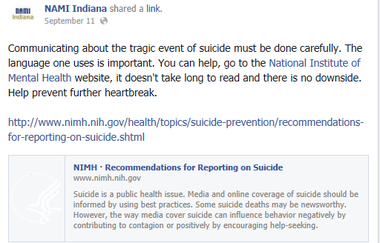
The MHA of Maryland used information provided by the Maryland Psychiatric Research Center's Early Intervention Program (EIP), a NIMH RAISE study site, to produce an EIP and psychosis fact sheet for its updated Family Resource Kit.
NAMI Minnesota live-tweeted from NIMH Director Dr. Thomas Insel's presentation at the 2014 NAMI Convention Research Plenary.
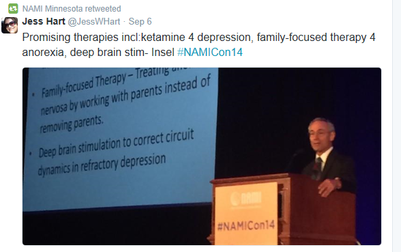
NAMI Southwest Missouri posted a recent blog entry by Francis Collins, MD, PhD, the Director of the National Institutes of Health, about the team approach to treating teen depression on its Facebook page.
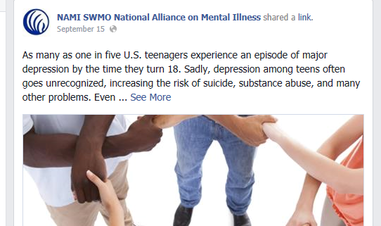
NAMI New Hampshire distributed NIMH publications at a training session with the deaf and hard of hearing community regarding mental illness and suicide prevention.
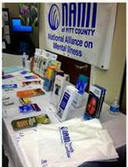 |
|
NAMI North Carolina posted a photo on Google+ of an exhibit featuring NIMH publications at a local mental health expo.
|
NAMI Ohio used NIMH information about post-traumatic stress disorder (PTSD) in testimony to support worker compensation for first responders with PTSD.
During May is Mental Health Awareness Month, Consumer Voices are Born, the Washington Outreach Partner, distributed NIMH brochures as part of presentations to at-risk high school students and families with children in the public mental health system.
Back to Top
After the Program's Annual Meeting, Partners are bringing the findings to their communities.

NAMI New York State (NYS) and NAMI Michigan shared summaries of the Annual Meeting presentations in their newsletters.
A number of partners, including NAMI Iowa, Mental Health America of Texas, and NAMI Virginia, linked to the Annual Meeting PPT presentations on their websites and enews.

NAMI NYS shared the NIH Record article summarizing the presentation by health policy expert Sherry Glied, PhD "Implementing Mental Health Parity in the Current Health Care Paradigm" via its enews.
|
Meeting Street, the Rhode Island Outreach Partner, provided updates to its Early Intervention Mental Health team, and Arizona State University gave relevant research updates to psychiatric nurse practitioner students.
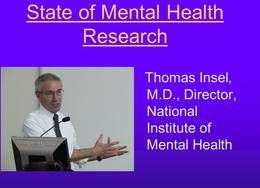
NAMI Iowa shared research findings at its affiliate meetings through a compilation of Annual Meeting presentations.
|
Outreach Partners conduct outreach projects addressing mental disorders among children and adolescents, or mental health disparities.
Mental Health Association of New York City: Mental Health and the Elder Boom

The Mental Health Association of New York City (MHA-NYC), through a contract jointly funded by the New York City Department of Health and Mental Hygiene and Department for the Aging, has been working to address the mental health needs of older adults. An estimated 20 percent of older adults have diagnosable mental and/or substance use disorders; that number is expected to rise as the “baby boom” becomes the “elder boom.” Older adults are more likely than their younger counterparts to live with one or more chronic physical illnesses and/or functional disabilities, which increase their risk for depression and social isolation. Yet there is a significant lack of both geriatric mental health specialists and mental health services available to provide care in the home, where older adults living with disabilities spend much of their time.
|
Among its efforts to address the mental health needs of older adults, MHA-NYC launched an effort in 2012 to reach underserved homebound older adults. The program featured telephone-based psychoeducation, depression screening, and linkage to evaluation and treatment services for those older adults at-risk for depression. Homebound older adults referred to the program were engaged in an interactive group workshop delivered by phone, individually screened for depression and, if indicated, linked to community-based treatment services. The telephone-based project served more than 650 older adults between 2012 and 2014. The interactive workshop incorporated NIMH information geared for older adults on topics such as depression. To learn more about MHA-NYC’s other older adult education and advocacy work, visit http://www.mhaofnyc.org/gmha/.
Back to Top
Outreach Partners are informing their communities about NIMH-funded trials actively recruiting participants.
The FFSC posted a blog highlighting the benefits of clinical research.

In observance of suicide prevention awareness week, the MHA NYC promoted NIMH-funded trials about suicide prevention seeking study participants via Tweeter.
Partners team up to connect communities with researchers to promote research participation and findings.
The University of New Mexico (UNM) Health Sciences Center, the New Mexico Outreach Partner, is participating in an NIMH-funded grant to pilot an intervention that combines group Interpersonal Psychotherapy, an empirically supported treatment, and the Historical Trauma and Unresolved Grief Intervention (HTUG), a Tribal Best Practice for American Indians. HTUG focuses on grief, depression, and trauma response resolution related to collective massive group trauma across generations and the lifespan for American Indians. UNM is working with two Indian Health Service funded clinics to deliver the interventions—one in New Mexico and the other in Pine Ridge reservation in South Dakota.
Back to Top
Partners provide opportunities for NIMH scientists and grantees to present their findings at local meetings and conferences.

At the NAMI Virginia State Convention NIMH grantee Kenneth Kendler, MD, from Virginia Commonwealth University presented the keynote, "The State of Psychiatric Genetics Research."
|
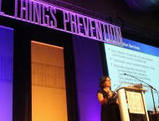
Amy Goldstein, PhD, NIMH Associate Director for Prevention Research, presented about Prediction and Early Intervention of Psychosis at the Mental Health Association Oklahoma (MHA OK) Zarrow Symposium. After the meeting MHA OK posted a video and summary of the presentation in a blog post.
|
Wisconsin Family Ties co-sponsored the training, Translating Emerging Brain Science into Positive Impact for Wisconsin's Children and Families, featuring NIMH grantee, Pat Levitt, PhD, from the Children's Hospital of Los Angeles' Institute for the Developing Mind.
Back to Top
|